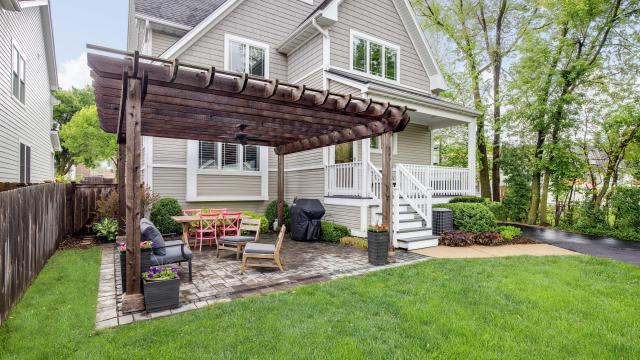With warmer weather and longer, sunnier days on the horizon, now is the time to get your yard ready for summer hangouts. If your yard doesn’t have many trees, consider adding shade — both to make the heat more manageable and provide protection from the elements.
You could plant more trees, but you may be waiting a while (years) before they’re big enough to provide much shade. But whether you plan to increase natural shade over time or not, there are a variety of other structures you can build to meet your backyard shade needs.
How to choose a backyard shade structure
There are a few factors you should consider in your shade structure selection:
- Purpose: Having shade for a single lawn chair or picnic table may require a different approach than providing a patio with full protection from sun and rain. Do you want to completely block the sun, or simply add shade?
- Temporary vs. (semi-)permanent: Temporary shade structures like umbrellas and tents can be easily moved around your yard or removed when not in use, while more permanent options like pergolas and awnings create a more complete look and more consistent shade. Shade sails, an in-between option, are usually anchored to the ground or walls but can be taken down when needed.
- Weather: If it rains a lot where you live, or if you have very hot weather with intense sun, pick materials and structures that hold up best and offer maximum comfort in those specific elements.
- Layout and design: You’ll want to consider how the sun and shade shift around your yard over the course of the day, the shape and layout of your space, and your personal design aesthetic. Are you putting up a freestanding structure or anchoring a pergola or awning to an existing patio or wall?
- Safety and upkeep: Similarly, make sure any structure takes into account drainage issues, wind, and proximity to your home, grilling area, etc. You should also consider care and maintenance for structures that could be impacted by rot and insects.
- Installation: While many shade structures are easy to DIY — as simple as opening up an umbrella — some may require specific tools or even professional help to ensure sound construction.
- Budget: Temporary structures are usually cheaper than permanent installations if you don’t want to spend as much.
5 shade options for your backyard
Let’s run down your backyard shade options, from temporary to more permanent.
Pop-up tent
A pop-up tent may not be the most aesthetically pleasing shade structure, but it’s easy to put up, take down, and move around as needed, and it blocks both sun and rain. As a bonus, pop-ups are portable for use while camping or tailgating. Note that tents probably won’t hold up well if left assembled in high wind.
Umbrella
Patio umbrellas come in a range of designs, sizes, and budget options, and like tents, can be easily moved or put away when not in use. Standalone umbrellas come with central poles and heavy bases or are cantilevered to stretch over your patio area. You could also get decent shade from an umbrella that fits in the centre of your patio or picnic table.
Shade sail or tarp
Shade sails provide coverage from rain and sun while allowing plenty of air movement. They’re usually attached to posts anchored into the ground, but the sail itself is adjustable and removable in case of high winds. They’re also relatively easy to DIY.
If you already have a pergola built in your yard but want more complete coverage, you can also attach a cotton-canvas tarp over the slats.
Pergola or gazebo
A pergola can be freestanding (either drilled into a deck or anchored with concrete) or attached to a wall to provide filtered shade over a patio or seating area. It won’t completely block the sun or provide protection from rain, and it does require more materials and installation know-how than a tent or tarp. You can either buy kits or design a pergola from scratch.
A gazebo is basically a pergola with a full roof, meaning more complete protection from the elements. Gazebos and pergolas can’t easily be moved or removed, so these are best for a defined shade space.
If you’ve already got a pergola or covered deck and want even more shade, consider hanging outdoor curtains or adding flowering vines like wisteria or grapes.
Awning or canopy
Awnings can be installed as an extension of a wall or roof or freestanding. You could also anchor a canopy to the railings of your deck. While awnings are more permanent, some are retractable if you want option of the sun exposure.

Leave a Reply
You must be logged in to post a comment.